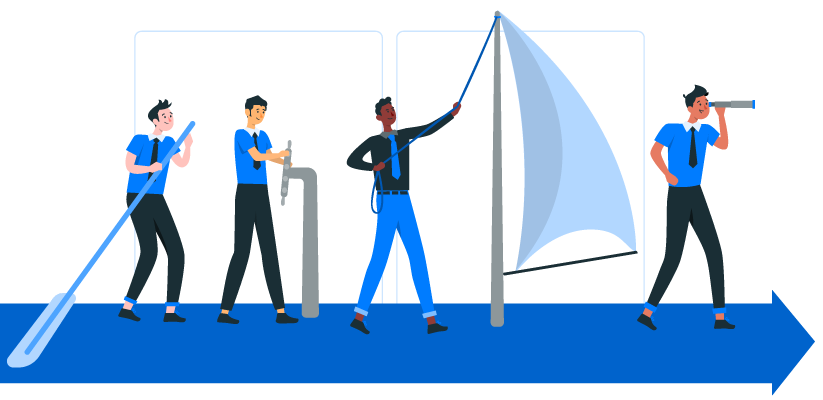5 Ways to Get a better handle on Team Dynamics
“About 75% of employers rate teamwork and collaboration as “very important.”
– Source: Queens University of Charlotte
According to another report, 86% of employees and executives cite lack of collaboration or ineffective communication for workplace failures. The importance of teamwork and collaboration is repeatedly emphasized by many universities and organizations as they reckon that it is extremely important to keep your team members together to increase the productivity and profitability of companies. In years of research, remote working had a good effect on the employees as it increased Employee engagement and also their job satisfaction.. Gallup’s report suggests that remote workers are 4% more engaged than office workers.
In today’s pandemic-stricken environment, remote working has been forced upon every worker across industries, be it manufacturing or IT. Earlier, remote working would have been a part of a hybrid model or adopted since the inception of a company or practiced by the gig economy. So, it worked well, but now, every employee and manager should mandatorily work from home with the available resources and existing team dynamics. Consequently, this unpreparedness will have a greater impact on the workforce and company. However, the organizations have arranged the necessary tools required to manage their employee performance. What about engagement and ways to thrive as a team? If you are a manager or a team leader wondering how to improve the team dynamics, continue reading the blog.
What is Team Dynamics?
“If a team is to reach its potential, each player must be willing to subordinate his personal goals to the good of the team.”
-Bud Wilkinson
Team dynamics is all about how a team member’s behavior, roles, responsibilities, and psychological factors affect other team members and the whole team. A high performer with a condescending attitude in a team will make other team members feel insecure and they become inexpressive of their ideas and opinions fearing embarrassment. On the other hand, there are employees who encourage each other and share their knowledge with others to help their peers grow and learn. Different actions have a different impact on the team.
What leads to Poor Team Dynamics?

Ways to Improve Team Dynamics
Clear Expectations
No matter how big or small your team is, but every member should be aware of what is expected out of them and the team’s common goal. If the expectations are clear, the team members would work together toward achieving their targets. Due to the COVID situation, most organizations have reset their objectives to stabilize and also thrive in these uncertain times. When an objective or a company’s direction is changed, every employee in the organization should be notified. The managers should conduct frequent meetings to change the course of every employee by revising the goals and reminding them of the changed business objective. When there is a lack of direction, there will be a lack of focus and wasted potential.
Strong Leadership
Leaders play a major role in the attitude of the team members. If the manager, who is a leader, does not act as a mentor to his/her team members, then the whole team will lack guidance and be reluctant to speak their opinions. In fact, the aggressors would start leading the team without your knowledge. A strong leader or a coach would listen to the team members, their ideas, and their concerns. The leader would then take action on it to build mutual trust and loyalty. When the team members trust their managers or team leaders, they would follow what their managers preach and change their attitude to suit their evolving team culture.
Constructive Feedback and the tone of the feedback
Managers should conduct frequent one-on-one meetings and deliver constructive feedback to help employees change their work behavior, if it affects professionalism, and suggest ways to improve themselves. But delivering feedback has certain rules. The feedback should not be pure negative criticism. It should start with a positive tone and then highlighting the areas for improvement. Most managers do not provide the solutions to overcome the shortcomings, which leaves the employees in a blank state. Therefore, leaders should also suggest ways as to how to improve weak areas. Besides, the managers should also be receptive to feedback and try to work on the opinions of their teams.
Frequent Effective Communication
In this remote working age, team dynamics can be maintained and improved only with frequent communication. The meetings should take place every day, and the managers should observe the team members to find out if they are engaged or are there problems that bother them. The managers should relay their good intentions of taking care of employee safety and well-being and encourage the employees to speak up their problems. This will also help employees to express innovative ideas too. Trust is the key. If it is built, the innovation and creation come as add-ons.
Flexibility and Autonomy
The employees should not be micromanaged but given autonomy to keep them engaged even while working remotely. The flexibility in work hours and autonomy will be much appreciated by your team members, and they will be able to focus more on the work and come up with more creative ideas, which can be discussed in the team meetings. Giving flexibility and autonomy gives a chance to the team members to build an understanding among themselves and perform better.
Follow these ways to keep your employees engaged and get a better handle on the team dynamics.
